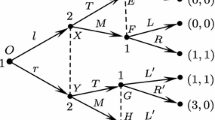Abstract
Given a normal form game and a signal generating process, we construct an expanded game in the spirit of Aumann (Econometrica 55(1):1–18, 1987) in which agents condition their strategic choices on perceived signals. We collect results on evolutionary selection dynamics of Ritzberger and Weibull (Econometrica 63(6):1371–1399, 1995), Swinkels (J Econ Theory 57(2):306–332, 1992b) and Samuelson and Zhang (J Econ Theory 57:363–391, 1992) to apply them to normal form games with payoff irrelevant signals. We suggest a selection dynamic for the evolution of signals and characterize the set of signal distributions and induced payoffs for sets that are asymptotically stable with respect to this evolutionary selection on signals.



Similar content being viewed by others
Notes
See Hart and Mas-Colell (2000), p. 1132 “(4) ... This implies, in particular, that interior (relative to Δ(S)) points of the set of correlated equilibria that are not pure Nash equilibria are unreachable as the limit of some z t [, the empirical distribution of play.] ...”
Proposition 2 in Lenzo and Sarver (2006)
By the Picard-Lindelöf Theorem, there exists a unique solution \(\hat \rho (\cdot ,\rho )\) for each initial condition \(\rho \in {\Delta }_{\mathcal {R}}\); see Weibull (1995) pp.232.
See also Swinkels (1992a), p.315
More technically, the suggestion is to increase the probability mass π(γ ′) or to decrease the probability mass π(γ ″).
References
Aumann RJ (1974) Subjectivity and correlation in randomized strategies. J Math Econ 1(1):67–96
Aumann RJ (1987) Correlated equilibrium as an expression of Bayesian rationality. Econometrica 55(1):1–18
Björnerstedt J, Weibull JW (1996) Nash equilibrium and evolution by imitation. In: Arrow K, Colombatto E, Perlman M, Schmidt C (eds) The rational foundations of economic behaviour. Macmillan, London, pp 155–171
Cripps M (1991) Correlated equilibria and evolutionary stability. J Econ Theory 55(2):428–434
Dawkins R (1990) The selfish gene. Oxford University Press, Oxford
Germano F (2007) Stochastic evolution of rules for playing finite normal form games. Theor Decis 62(4):311–333
Hart S (2005) Adaptive dynamics. Econometrica 73(5):1401–1430
Hart S, Mas-Colell A (2000) A simple adaptive procedure leading to correlated equilibrium. Econometrica 68(5):1127–1150
Hart S, Mas-Colell A (2003) Uncoupled dynamics do not lead to Nash equilibrium. The American Economic Review 93(5):1830–1836
Hart S, Mas-Colell A (2013) Simple adaptive strategies: from regret-matching to uncoupled dynamics, vol. 4 of World Scientific Series in Economic Theory. World Scientific, Singapore
Koch LP (2008) Evolution and correlated equilibrium. Bonn Econ Discussion Paper 14/2008
Lenzo J, Sarver T (2006) Correlated equilibrium in evolutionary models with subpopulations. Games Econ Behav 56(2):271–284
Mailath GJ, Samuelson L, Shaked A (1997) Correlated equilibria and local interactions. Econ Theory 9(3):551–556
Maynard Smith J (1974) The theory of games and the evolution of animal conflict. J Theor Biol 47:209–221
Ritzberger K, Weibull JW (1995) Evolutionary selection in normal-form games. Econometrica 63(6):1371–1399
Samuelson L, Zhang J (1992) Evolutionary stability in asymmetric games. J Econ Theory 57:363–391
Sandholm WH (2011) Population games and evolutionary dynamics. MIT Press, Cambridge
Selten R (1980) A Note on evolutionarily stable strategies in asymmetric animal conflicts. J Theor Biol 84:93–101
Skyrms B (2010) Signals: evolution, learning, and information. Oxford University Press, Oxford
Swinkels JM (1992a) Evolution and strategic stability: from Maynard Smith to Kohlberg and Mertens. J Econ Theory 57:333–342
Swinkels JM (1992b) Evolutionary stability with equilibrium entrants. J Econ Theory 57(2):306–332
Taylor P, Jonker L (1978) Evolutionary stable strategies and game dynamics. Math Biosci 40:145–156
Weibull JW (1995) Evolutionary game theory. MIT Press, Cambridge
Author information
Authors and Affiliations
Corresponding author
Ethics declarations
Conflict of interest
The author declares that he has no conflict of interest.
Rights and permissions
About this article
Cite this article
Metzger, L.P. Evolution and correlated equilibrium. J Evol Econ 28, 333–346 (2018). https://doi.org/10.1007/s00191-017-0539-z
Published:
Issue Date:
DOI: https://doi.org/10.1007/s00191-017-0539-z
Keywords
- Correlated equilibrium
- Replicator dynamics
- Evolutionary stability
- Asymptotic stability
- Evolution of signals




